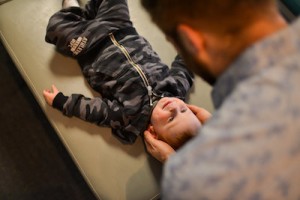After almost a decade of caring for sensory and spectrum kiddos, and years of constantly reading and learning everything there is to know about them, I can tell you that they really struggle with three main elements of life that all start with the letter C.
In turn, when the right forms of care are applied, the right protocols and methods used, these “3C’s” drastically improve, thus greatly increasing the child’s quality of life. And we all know that when the child gets better with these 3 elements, life for the whole family gets better!

CALMING.
This article is not one meant to spell out the entire scientific mechanisms behind sensory and spectrum disorders (that’s what the Perfect Storm workshop does), but to sum that all up what we know is that these kids are very much locked into and “stuck” in a state of Sustained Sympathetic Dominance (SDS). The sympathetic system is the “gas pedal” side of the Autonomic Nervous System, and therefore when it’s over-stimulated and activated, these kids are constantly “revved up” and wound up even at rest.
This means that they are very easily agitated and irritated, and are NOT easy at all to calm down.
Because the sympathetics are running in a constant state of high arousal in these kids, they are extra sensitive to almost all forms of sensory stimuli. The lights are “brighter” to them than non-sensory kids, the sounds “louder” and the seams and tags on their shirts and clothes “scratchier” than they should be.
So this all leads to a “vicious cycle” where an already overstressed system is constantly over-stimulated and irritated again and again by even the “normal” things in life. Now throw in a classroom with 27 other highly wound up kids, a busy and noisy restaurant, a birthday party at Chuck E Cheese, a family holiday get together, or a water park environment… and forget it, these kids “red line” and emotional, behavioral outbursts become the new normal for these kids and their families.
They simply can’t calm down, because their nervous system can’t calm down.
CONNECTION.
This one as well as the next, actually stem from the first – a non-calm, overactive sympathetic nervous system. When these kids are constantly on the fight/flight “gas pedal” response, they simply don’t have the time and ability to slow down and CONNECT to what’s really going on around them – from parents and teachers, to peers, etc.
Their brain literally is in a state of fear, stress, and anxiety at nearly all times… thus it doesn’t have the ability to handle other non-emergency functions like communication, eye contact, and social engagement. Reciting the ABCs, singing a song, or having a conversation are just not important to-do’s for a nervous system that is constantly worried something is going to jump out and attack it.
These kids are in constant “protection” or “defense” mode, so they aren’t spending adequate time in “growth” and “development” mode… aka CONNECTION mode.
COORDINATION.
The simplest and most common place this one is seen and discussed with these kids is in the Motor System – movement, balance, etc. The “nerdier” terms for those functions are ones that parents of sensory and spectrum parents are familiar with, when they probably wish they weren’t and didn’t have to be… things like proprioception, vestibular function, and kinetic or spatial awareness.
The most common places these challenges show up in day-to-day life are speech and verbal communication, meeting developmental milestones (tummy time, rolling over, crawling, walking, etc.), posture, running, walking, climbing, hand-writing, visual accommodation, etc. The parents report to us that these kids are constantly falling down, tripping, and seem to have “two left feet” most of the time, struggling with athletic and other physical endeavors.
But what’s important to know is that the troubles with Coordination don’t just show up in the Motor System, it’s much more than that.
The entire body relies on Neurological Coordination amongst the various major Systems of the body, and honestly down to each and every cell. They are all inter-connected and their function is dependent upon those connections, so when that is compromised, so are many other things.
So while everyone knows that children with Autism Spectrum and Sensory Disorders can struggle with things like Speech, Motor Planning, and Social Engagement types of Connections – they also frequently struggle with the “Connections” between their Immune System, Digestive System, Respiratory System and more.
These children routinely suffer from things like indigestion and constipation, allergies and asthma, frequent colds and respiratory issues, and more.
If a child can’t CALM down and slow down, they are always going to struggle to CONNECT and COORDINATE.
The other thing you’re likely saying to yourself is, “Ok, that makes sense – now what can I do to help my child better calm, connect, and coordinate?” Glad you asked! If you have more questions, the Perfect Storm is the perfect event to attend. If any of the above sounds like your child(ren) this will be a great opportunity to learn more and also connect with some of the best resources our community offers! If you’ve followed us for long enough and know it’s time to connect with one of our Care Team Members, give us a call at 763-383-5109
 Request Appointment
Request Appointment Email Us
Email Us Office Hours
Office Hours